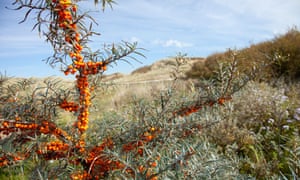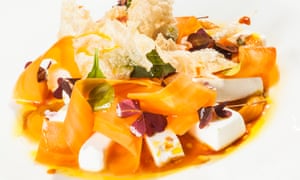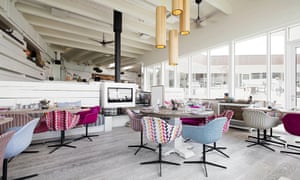Tallinn’s ‘new Nordic’ food scene – and the restaurants leading the way | Travel
Behind the medieval city of Tallinn, a former Hanseatic port and a Unesco world heritage site, the woods run to the Russian border. The Estonians have sought their shelter in times of trouble: forest covers 90% of this tiny EU country on the Baltic, and with Russia next door, trouble has never been hard to find. “The forest is a fur coat,†says an Estonian proverb. But now it offers more than warmth and shelter: a young generation of Estonian chefs are using it to feed a cooking revolution, too.
Whether it’s spruce shoots or pickled ramsons, blackcurrant leaves or grated green pine cones, Estonian chefs are returning to the forest â€" and to the miles of Baltic sea that ring the stony beaches of the coast and islands â€" using the startlingly brief warm summers to track down folk flavours that they combine and adapt in unexpected ways. This is the “new Nordic†cuisine as pioneered at Noma in Copenhagen by René Redzepi, with an Estonian twist: fresh, local, making the most of its seasons. And unlike Noma, it doesn’t have to cost the earth. Estonian chefs don’t have a big middle-class clientele to cater for, so it remains good value.
For chefs who were not born when their country regained independence in 1991, the revolution is all about food. They have travelled to Finland, Sweden and Denmark, worked in kitchens across northern Europe, and imbibed the Nordic style first hand. The idea is to get away from the peppers/garlic/tomato triumvirate behind Mediterranean-inspired cookery, and instead use their skills to put a spin on traditional ingredients and techniques. In a country that spends eight months of the year in wintry darkness, that means a lot of fish and game, and plenty of food preservation: smoking, pickling, salting and drying.
Perhaps surprisingly, Estonia was one of Britain’s traditional sources of bacon before the second world war, and the black flitches laid out in the market at Tallinn’s Baltic Station suggest that nothing has been forgotten; it’s well worth getting out of bed for thinly sliced Estonian streaky bacon on toast. Meanwhile, those long dark nights drive Estonia’s chefs to pounce on startling colours, like orange sea buckthorn berries, or rapeseed oil infused with chives.

For the two chefs at Leib (see below), which opened in 2011, it has meant working directly with farmers and promising to buy their entire output of young vegetables, which have to be cured or preserved the moment they arrive. Orm Oja, the young head chef at Noa, remembers getting baby carrots for free from old ladies in the market who couldn’t understand why he wasn’t buying their giant roots. But the old ladies have their secrets, too, and these young chefs know it’s worth listening to grandma when she explains about the herbs, grasses, folk remedies and the forest fruits that sustained Estonians through the tribulations of the 20th century.
The movement is still small, and in a country of 1.3 million people, finding chefs is an ongoing challenge. But then, so too is finding diners prepared to pay European prices, so eating out in Tallinn is relatively cheap. Some chefs have opened a sister restaurant for high-rollers, but the destinations below operate as everyday restaurants, with high presentation and cookery skills. Just as Estonians have aligned themselves with the sleek design and minimalist aesthetic of their Scandinavian neighbours, so they’re bringing a new energy and enthusiasm to Tallinn’s tables.
Leib Restoran

Leib means “black bread†in Estonian â€" “fresh, warm, simple and honestâ€, just what chef Janno Lepik and sommelier Kristjan Peäske wanted when they opened Leib in a courtyard beneath the medieval walls. It still belongs to Tallinn’s members-only Scottish Club, with a cabinet of single malts and a statue of Sean Connery in the garden, but visitors will find a weekly-changing menu of fresh wild and organic dishes, and drinks that include the house-fermented kombucha, and rowanberry schnapps. There is a lot of pike perch and other fish, and a dessert of frozen yoghurt and cherry cream is enlivened with shavings of Jerusalem artichoke and grated egg yolk.
• Mains from €13.50, Uus 31, +372 611 9026, leibresto.ee
Noa

There’s a 12-course tasting menu for €89, but more affordable main courses too. Here, 23-year old chef Orm Oja has been experimenting with some hardcore traditions, like exploiting the natural fermentation of overwintered vegetables. He’s interested in using ants, too, to create a starter for sourdough bread, the way peasants did when freezing winter weather killed off their starter. It also has a fire pit where Noa’s chefs recreate the tarry, pungent heat of a traditional Estonian sauna. Expect salt fish, piglet with smoked apple, and scallops served with spruce shoots and lime.
• Mains from €13, Ranna tee 3, +372 508 0589, noaresto.ee
Kaks Kokka

In the larder, 34-year-old chef Ranno Paukson points out slippery green bags of pickled ramsons â€" wild garlic leaves harvested from the woods â€" alongside stacks of wild brain mushrooms in boxes, waiting to be preserved; shelves of alluring jars twinkle in the restaurant. It’s all woods and water for the two young chefs (the other being Martin Meikas) who grew up on the little Baltic island of Muhu, off Estonia’s west coast, and brought their formidable talents to Tallinn three years ago. Salted elk is paired with Icelandic moss, pike with marinated cauliflower. There are big flavours and fabulous presentation, and behind the scenes, the chefs are experimenting with curing lamb and creating their own black garlic.
• Set five-course menu €44, mains from €11, Mere puiestee 6E, +372 661 6151, kakskokka.ee
Mon Repos
The menu at chef Vladislav Djatšuk’s award-winning renovation of a 100-year-old restaurant is not so much “new Nordic†as an exploration of regional tradition and history. Djatšuk has worked in Finland, Denmark and France, where he reached the finals of the Bocuse d’Or, and also worked his way through Tallinn’s town archives to dig out czarist-era recipes that he uses to concoct ultra-modern dishes that speak to the grandeurs of the past, such as pigeon in madeira or lavaret (a variety of salmon trout), served with shrimp mash and a crayfish bisque. The building is in a park overlooked by Tallinn’s Kadriorg Palace, built by Peter the Great for his Czarina.
• Mains from €12, Narva maantee 92, +372 507 0273, monrepos.ee
BaoJaam

Only in Estonia â€" where means can be limited and chefs may want to avoid the costs and risks of setting up a fine-dining restaurant â€" would the winner of the Best Chef in Estonia Award, 26-year-old Mihkel Rand, choose to work 18-hour days at the counter of his new Chinese-inspired bun shack. In the newly-renovated Baltic Station market, where bacon, elk and smoked fish the colour of an old pub ceiling is for sale in the food halls, BaoJaam brings delicious squishy baoz buns together with barbecued meat, chicken and fish for a cheap and wildly popular street food hit.
• Dishes €7, Balti Jaama Turg, no phone, Kopli 1, on Facebook

0 Response to "Tallinn’s ‘new Nordic’ food scene – and the restaurants leading the way | Travel"
Posting Komentar